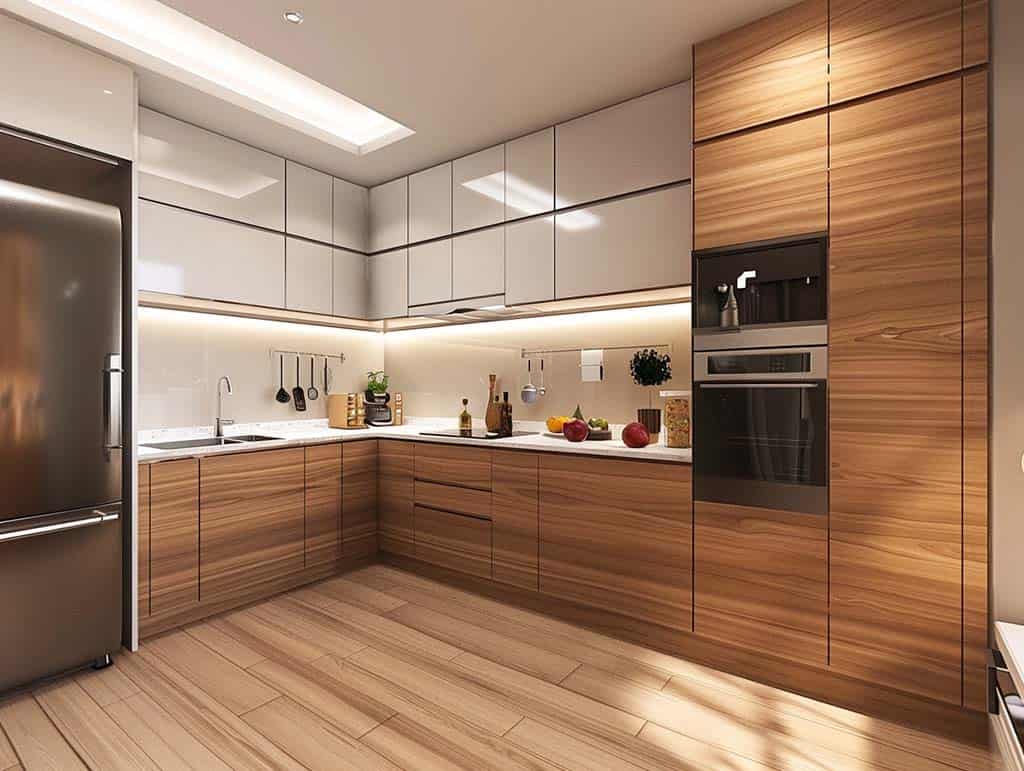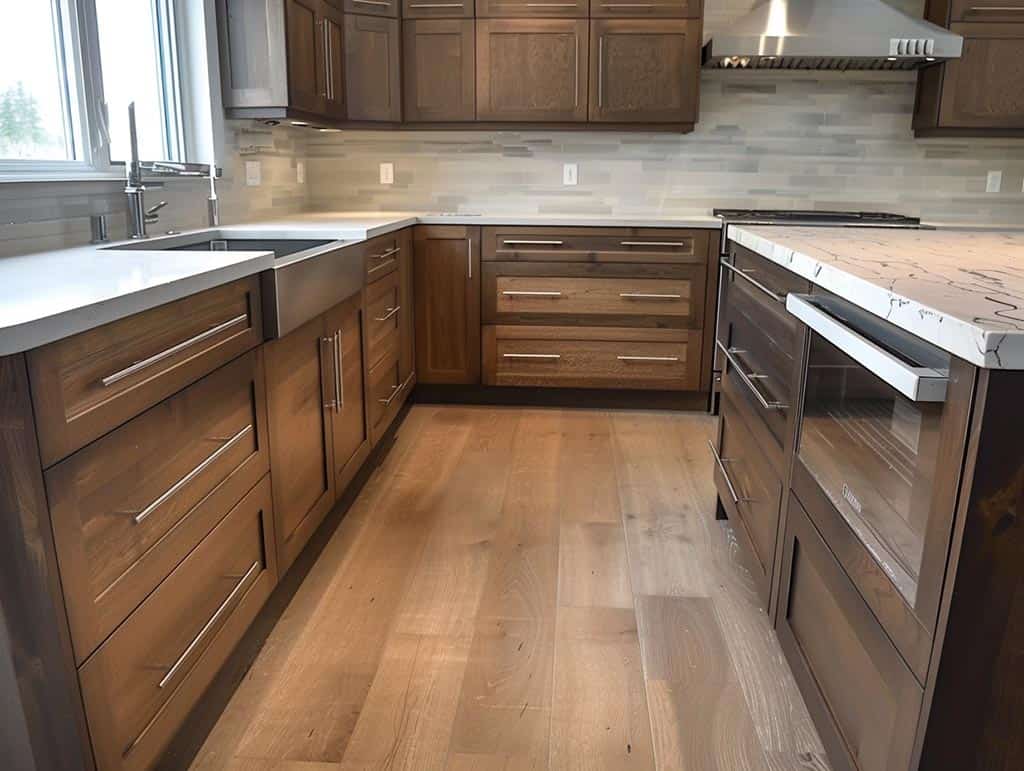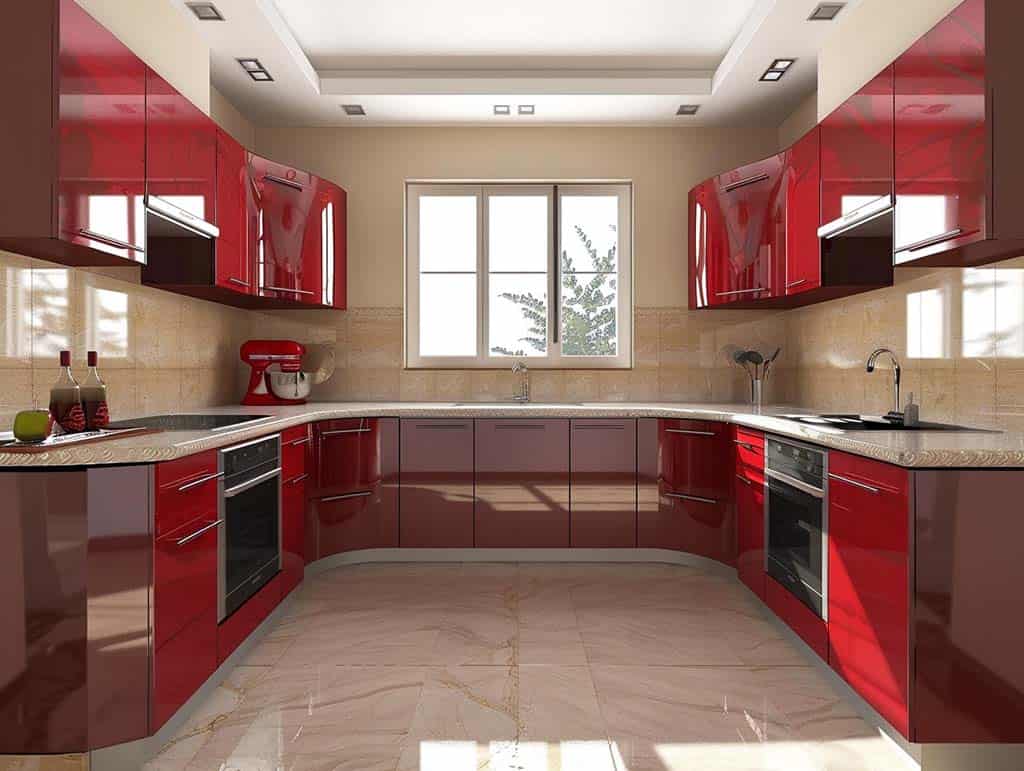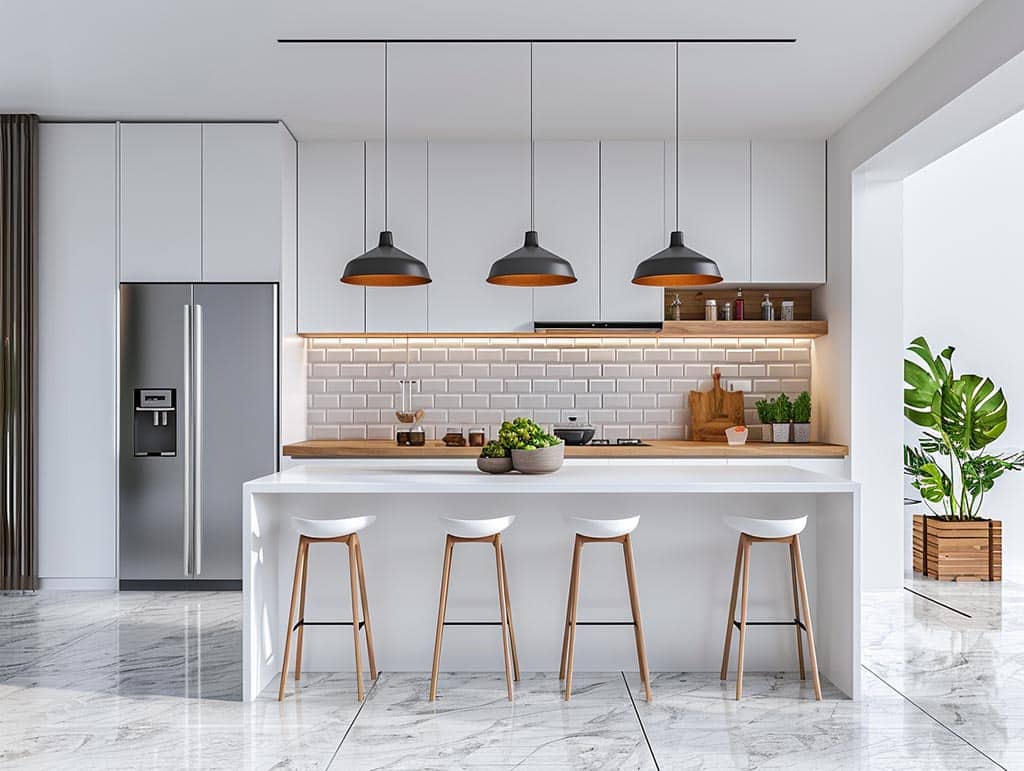
The kitchen is usually where homeowners invest a large portion of the budget they have set aside for interior design. It is therefore important to protect this investment with high-end kitchen cabinet materials. Poor design can make the kitchen, which is often at the centre of a house, a source of daily misery. Low-quality kitchen cupboard materials can reduce its service life and even compromise safety.
You may be surprised by the price of a kitchen renovation if you’ve not done enough research on the different materials for kitchen cabinets. For example, solid wood and metal are the most durable kitchen cupboard material types. However, they are much more expensive than wood veneers and other substrates. For the whole kitchen project, the price can be unbearable. Therefore, you will want to find a way to reduce the cost and speed up the process. Laminate and MDF can come to the rescue but how reliable are they?
Get all the knowledge you need for a seamless kitchen renovation with the Trendstyle guide to kitchen cabinetry materials, which covers characteristics, benefits, and considerations to fit your vision and lifestyle.
What are the components of a kitchen cupboard?
Cabinets are an integral component of the kitchen, and choosing their material plays a pivotal role. Kitchen cabinet material options vary according to aesthetic preferences and practical considerations. But let’s first delve into the anatomy of cabinets.
A carcass is simply the structure of a module that holds the panels at the top, the bottom, the sides and the back. Kitchen carcass material should withstand loads of kitchen inner shelves with stuff as well as allow hinges, cabinet doors and hardware to be attached. Kitchen base cabinets are usually equipped with PVC legs that can be raised or lowered to adjust the required height. Pay attention, that the benchtop will be installed last. Its height is usually not included in overall cabinet dimensions and is measured separately.
Kitchen drawers consist of a few components that contribute to their functionality and durability. A kitchen drawer material is typically wood, plywood or metal. It serves to support and store its contents safely. The drawer front is the visible face of a drawer, typically comprised of matching material as the cabinet door finishes for aesthetic reasons.
Drawer slides are mechanisms designed to allow drawers to open and close smoothly. Drawer glides enable the drawer to move in and out. Both made of metal or plastic, these should be strong enough to bear the weight of drawer contents.
Kickboards (toe kicks) are installed at the base of kitchen cabinets, islands and other fixtures to create a recessed space between their bottom surface and the floor. Kickboards help prevent debris and dust from gathering under cabinets and act as a protective shield from potential damage caused by mops or vacuum cleaners. In this setting, choosing the best material for the kitchen kickboard, durability and moisture resistance must be prioritized.
Mouldings and valances add both aesthetic charm and architectural detail to the kitchen space. Crown moulding is decorative trim that is applied to the exterior edges or surfaces of cabinets to conceal gaps between them and the ceiling. Valances are decorative pieces installed below upper cabinets or above sink areas for hiding under-cabinet lighting fixtures.
Types of kitchen cabinet materials
Unraveling the essence of various materials used for kitchen cabinets that form their core is essential as the kitchen is the most heavily used room in your house. Your choice of materials for kitchen cabinets will have a greater impact than just appearance. Types of kitchen cabinet materials vary in terms of durability, maintenance, ease of refinishing, and cost.
You should have a good understanding of the pros and cons of different kitchen cabinet material types. This information can help you make the proper comparison and the right choice eventually. It may be tempting to choose a cupboard material that matches the aesthetic of your home, but it might not hold up to the demands of a household, for example, with children.
From timeless classics to more affordable modern solutions, there is a typical kitchen cabinet materials list:
- Solid wood;
- MDF (Medium Density Fiberboard);
- Plywood;
- Particle board.
Each cabinet material can be utilized differently in the kitchen to maximize its individual benefits. For instance, kitchen cabinet wood materials can be utilized for cabinet doors and drawer fronts due to their natural beauty and pleasing texture. Plywood makes a reliable material choice for drawer boxes and shelves while MDF offers affordability and versatility for intricate detailing such as side panels or mouldings.
Solid wood for kitchen cabinets

Hardwood has always been and remains the most common material for kitchen cabinets in Australia. The wide range of wood species and design styles available means that there is something for everyone. When it comes to durability, solid wood kitchen cabinet strength can differ depending on the species. Meanwhile, solid wood cabinets can be used in the kitchen on a daily basis.
It would take significant moisture and years of temperature, humidity and changes in order for the kitchen cabinet’s solid wood to warp. Still, wood panels are subject to warping as they expand and contract according to temperature or humidity changes.
If you are planning to paint your solid wood kitchen cupboards, grain patterns are not something to worry about. The primer and the paint won’t reveal them. However, you should choose a paint-grade kitchen cabinet solid wood such as birch. As natural material contracts and expands due to temperature fluctuations, a painted finish may be susceptible to cracking.
You can work with solid hardwood in various ways to highlight its natural qualities but staining is what will emphasize the material at its best. Stain allows the knots, grains and wood features to be prominently displayed. No two pieces of solid wood panels for cabinets are identical. As with the trees, each slab will have slight variations, giving your cabinets a unique, beautiful look.
At the same time, wood stains for kitchen cabinets don’t always adhere evenly throughout the slab and can produce an uneven, blotchy or sometimes even streaky finish. Also, it can be difficult to predict the wood colour of cabinets after staining due to variations in hardwood properties.
The price of solid wood kitchen cabinets in Australia can be affected by a particular wood type. So you should do your research before choosing wooden cabinets. Here are the few most common types of wood used for kitchen cabinets:
| Wood type | Properties |
|---|---|
| Oak | Oak is one of the most popular choices for wooden cabinets in kitchens. It is strong and durable, but also affordable when compared with other wood used for cabinets. Oak is not suitable for smooth finishes as its grain patterns cannot be hidden. |
| Maple | Maple is a slightly more expensive alternative to oak. This is the best wood for kitchen cabinets if you like finer graining. Maple wood is a light species, which gives any kitchen a more contemporary and airy look. Still, it can be stained in any colour you choose. |
| Walnut | Walnut has a uniform, smooth grain that looks like swirls. It ranges from a dark chocolate brown to a light reddish grey turning lighter with age. It is also very easy to carve, making it a great high-end wood option for kitchen cabinets. |
| Hickory | Hickory is a very strong wood with a grain similar to oak. Its colour and tone are quite diverse. The wood’s tones range from a light cream to a reddish brown or black. Hickory looks best in a clear or natural finish. |
| Birch | Birch is an affordable and durable choice for custom cabinetry. The wood has a curly pattern, a silvery blonde colour and a soft, satiny sheen. The birchwood hardness makes the cabinets durable and strong; at the same time, it is difficult to work with. |
Although solid wood kitchen sets are durable enough to withstand daily usage, you should consider other factors, such as the wood species, grain pattern, and finishing technique, to achieve your desired kitchen design. Understanding the characteristics of various wood types will help you choose the best kitchen cupboard materials, no matter if you’re looking for affordability, strength or aesthetics.
Is MDF good for kitchen cabinets?
MDF kitchen panels are a great choice if you’re looking to save money without sacrificing quality. Medium-density fiberboard for kitchen cabinets is made from small wood fibres that have been glued with resins and then hot-pressed. A few types of kitchen cabinet MDF are standard sheets, Ultra-Light MDF a lightweight version, moisture-resistant MDF – with edges treated, laminated MDF and veneer-covered boards.
These options are affordable and can be covered with any type of finish. For instance, laminated MDF kitchen cabinets usually are able to withstand moderate moisture. Cabinet-grade MDF is typically used to make all standard kitchen cabinetry, except for those under-the-sink units.
- MDF kitchen carcasses are durable and provide structural support and dimensional stability, acting as a reliable foundation for cabinet doors, shelves and drawers.
- MDF kitchen cabinet doors. This engineered wood suits MDF kitchen cupboard doors as well, as it has a smooth texture. A kitchen MDF board homogeneous nature allows it to have grooves or profiles. This makes it a good choice if you want to go for a traditional appearance for your kitchen facades.
- MDF cornice moulding is a popular choice for kitchens. Due to its ability to be easily formed into intricate designs, MDF kitchen cornice and pelmet suit either cabinetry or complement kitchen decor.
- MDF kitchen kickboards offer an easy and seamless connection between cabinets and the floor in the same way as mouldings. The difference is a toe kick often comes into contact with moisture during cleaning. Still, MDF plinths allow quick installation and can be tailored according to the size, shape, finish or design aesthetic of the kitchen.
Kitchen cabinets require regular care and upkeep to look their best. MDF cabinet maintenance is essential to their durability, longevity, and aesthetic appeal. You can easily clean MDF cabinet surfaces by using a soap solution with a soft cloth.
Providing a comparison of MDF kitchen cabinets vs wood, plenty of kitchen manufacturers note that high-end MDF is more durable and smoother compared to solid hardwood as it does not have any knots or wood grains. As a cabinet kitchen material, Medium-Density Fiberboard is known for its durability and resistance to warping or sagging over time.
Plywood for kitchen cabinets
Plywood can be made by pressing together and binding multiple thin wood layers to create a durable product. It’s available in different thicknesses, with plywood thickness for kitchen cabinets on average 18-30 mm. The higher the kitchen cabinet plywood thickness is, the stronger and not susceptible to cracking it turns. Likewise, a general rule states that the thicker plywood edges are the better choice, 19 mm thickness works well for a plywood kitchen carcass.
The lamination process makes kitchen cupboard plywood extremely durable with minimum chemicals used. Still, every plywood has to have a face veneer. When sanding and polishing thin veneered cabinet materials for the kitchen, you may face significant challenges. If holes and knots can be seen within the veneer, the problem will become more widespread.
Plywood is suitable for all aspects of cabinetry, including doors, drawers and fronts. There are three grades of plywood for a modular kitchen to consider. It is important to note that the higher the grade the more expensive is plywood modular kitchen price. If you want long-lasting results, however, this should not be a concern.
- A-cabinet quality plywood is the best because the face veneers are perfect. This makes it smooth and expensive.
- B-grade plywood has a low knot count. Tight knots smaller than 25 mm in diameter can be allowed.
- In C-cabinet grade plywood, there are a few knots of up to 35 – 40 mm in diameter.
Panels with A or B stamped on them are the best for plywood kitchens in Australia. When choosing the best plywood for the kitchen, consider in advance what type of finishing you would like to apply. For even painting it’s important to check the surface flatness.

If you choose birch plywood for a kitchen, it will be resistant to warping or rotting. However, pay attention that birch veneers are absorbing stains leading to uneven tone of finishing. Considering its natural finish, exposed edges and light wood, birch plywood kitchen doors can be a good choice for those who love light wood kitchens. This will allow you to have a beautiful appearance and durable units. As an alternative, plywood kitchen cabinetry does not need to be finished. You may choose to highlight a simplistic finish to the naturally light wood for a Scandinavian kitchen with plenty of natural materials.
Plywood kitchen cupboard doors may have either exposed or treated edges. When designing fully painted plywood kitchen cabinet doors choose a plywood that has an attractive finished edge. This will avoid the need for an edge band, which can complicate manufacturing and finishing. Plywood kitchen doors can be also decorated with inserts and various beaded grooves.
Although the same kitchen cupboard material may be used to make door and drawer fronts, and end panels, the construction of drawer boxes and their lining can differ. They may be constructed from thinner plywood. The sides of plywood kitchen drawers are made from 12mm thick ply, while the bottom is 6mm thick. This thickness is universal, but for heavy-duty drawers, you can specify a thicker ply.
Particle board for kitchen cabinets
Particle boards are made primarily of pressed wood fibres and adhesives with thin sheets of veneer or plastic laminate attached. Since this kitchen cupboard material is cheap, particle board cabinets are more affordable than MDF, solid wood and plywood. Because particle board is light, not only does it cost less to purchase, but it also makes it cheaper to deliver and easier to install. A particleboard kitchen can be a good choice if you want to use the least expensive material possible for your cabinets.
There are many different styles and colours of kitchen cabinets made from particle board that you can select to match your kitchen aesthetic. A wide range of finishes is available for particle board kitchen cabinet makeovers to suit every taste, whether you want a minimalist design, textured surfaces, glossy finishes or wood grains. With a lot of options, you can create a unique kitchen on a tight budget.
However, humidity and moisture will cause particle board kitchen cabinets to expand and warp. The low water resistance of particleboard is the main issue, especially in areas where humidity is constant, such as above the range or near the sink.
Be prepared for cabinet particle board not to last very long, especially in areas with heavy use like the kitchen. Particle boards are not as durable as other types of materials for kitchen cabinets. You should handle them with care and prevent damage as they can not support large amounts of weight. This material will wear and tear and lose its aesthetic appeal in a much shorter time than, for example, kitchen solid wood cabinets.
Kitchen cabinet door materials
The importance of kitchen cabinet door material options over cupboards itself lies in visual appeal. Since cabinet fronts take a significant place in your kitchen, they serve as a focal point, drawing attention and setting the tone for the entire space. In addition, cabinet doors are used the most – you open and close them constantly, even slam doors, and grab them with wet hands. Kitchen cabinet door materials must be strong enough so that the hinge holds the weight of the door, and the finish resists moisture and daily wear.
Cabinet manufacturers often use different types of material used for kitchen cabinets and cabinet doors. It is common to find this feature in both high-quality cabinets to increase functionality, and in mass-produced cabinetry to lower the price. It is widespread as well to use secondary wood to make parts of a cabinet that aren’t visible, such as backs and drawer sides. This may be done to reduce the cost of materials, or for practical reasons. For example, it is best to use modern kitchen cabinet materials such as MDF or plywood, instead of natural wood drawers for kitchen cabinets which may lose the ability to be easily opened due to humidity changes.
Still, solid wood kitchen cupboard doors can be used to enhance overall room appeal if they are combined with other material boxes and side panels. Solid wood shaker kitchen doors stained and finished in a wood grain pattern are the best choice for a classic and luxurious aesthetic.
The cheaper option that offers the same level of luxury is wood veneer kitchen doors. With the same hardwood grain allure, timber veneer kitchen doors can be more affordable, lightweight and easy to maintain. If the veneer is in good shape, you may not even be able to tell it’s not a solid piece. You don’t until it needs to be refinished that it becomes necessary to sand it. Because the veneer is thin, aggressive sanding can wear it down quickly. Hence, oak veneer kitchen doors are not able to have distressed surfaces because of the material below.
In comparison with solid wood kitchen cabinet doors MDF works better for cabinet fronts that will be painted. Due to the smooth surface of raw MDF kitchen slab, the paint sticks in the most even layers compared to other materials. MDF is available with a melamine or laminate that can mimic a natural look. Laminated kitchen cabinet doors are more resistant to moisture, making them a waterproof option.
What is the best material to choose for kitchen cabinets?

It is not easy to choose the right material for your cabinets. Your final product should be attractive, but it must also be durable and functional so that you can use it for many years. Different kitchen cabinet materials used will also influence the design of your kitchen.
While traditional choices are time-tested, the latest materials for kitchen cabinets are also made sustainable and practical, which helps to save on future renovations and design a functional kitchen. Choosing the best kitchen cabinet material involves considering their durability, aesthetics, sustainability and functionality. Here are some practical tips to help you make an informed decision:
- Consider modular kitchen options. When selecting modular kitchen material types you have a chance to choose those which are durable, easy to maintain, moisture resistant and can provide a variety of styles and colours.
- Search for sustainable kitchen materials. Sustainability is becoming more of an important consideration among homeowners, so consider eco-friendly materials for your kitchen cabinets such as FSC-certified wood, bamboo or reclaimed wood which have low environmental impacts compared to more traditional options.
- Select waterproof material for kitchen cabinets. Due to high moisture levels in kitchens, selecting a waterproof kitchen cabinet material is absolutely crucial. Look for marine-grade plywood, or water-resistant MDF that can withstand leaks, spills, and kitchen humidity.
- Look for sleek minimalist designs featuring clean lines and integrated handles. The fewer details your cabinetry has the easier it is to maintain the cleanness and good shape of units and doors.
Before making your decision, carefully investigate and compare the different kitchen cabinet materials’ pros and cons. Solid wood offers timeless beauty while being not enough resistant to warp in humid environments; engineered wood products like MDF or plywood offer exceptional moisture resistance while lacking longevity. By conducting comprehensive research, you can select an option that meets your needs, preferences and budget.
FAQ
Some signs that indicate poor-quality cabinets include sagging shelves, loose hinges and wear and tear like peeling edges from laminate or warped doors. Poorly constructed cabinets may feature uneven seams or gaps between door frames and their doors. Using such units is a safety risk for your family, especially kids.
What material are kitchen cabinets usually made of?
Common kitchen cabinets can be constructed from materials such as solid wood, MDF, plywood, and particle board. Each material has its own advantages and disadvantages in terms of durability, cost, and aesthetic appeal. The Trendstyle blog post above offers comprehensive information about types of kitchen cabinet and door materials.
Are mdf kitchen cabinet doors good for painting?
MDF cupboards are commonly considered suitable for painting. MDF is an extremely uniform material that offers smooth finishes when painted. Furthermore, MDF cabinets is available with various finishing like melamine or laminate coatings which further increase their durability.
What plywood to choose for kitchen cabinets?
When selecting plywood for kitchen cabinets, prioritize A-grade or B-grade plywood for smoother surface finish and 18-20mm thickness for strength and stability. Moisture-resistant (MR) plywood should also be considered to prevent warping and mold growth as well as high quality face veneers that enhance appearance. By carefully considering these factors you can ensure durable yet visually appealing kitchen cabinets that withstand everyday usage.
Can I use solid wood cabinets in my kitchen if I live in a humid environment?
While solid wood offers natural beauty and durability, it may not be the best choice for kitchens in very humid environments. The wood can warp or expand in response to moisture levels, potentially affecting the cabinet’s integrity over time.
